The construction of new homes is not being distributed equally across San Diego's cities, a new analysis by Voice of San Diego and KPBS found.
Our analysis examined the number of new homes — ranging from apartments and accessory dwelling units to single-family homes — permitted across San Diego County between 2018 and the end of 2024.
From a pure volume standpoint, the city of San Diego, the largest city by far, unsurprisingly permitted the most homes.
But on a per capita basis, Chula Vista permitted the most — 38 new homes for every thousand residents over the six-year window. El Cajon permitted the least, just 9.9 homes per thousand residents.
The reasons why cities permit more or fewer homes depend on a variety of complicated factors, including desirability, open space and zoning laws.
Chula Vista
Chula Vista, for instance, is unique among San Diego cities: It actually has some large swaths of open land, particularly in its southeastern corner.
Chula Vista, unlike most other cities, also had a diverse range of housing types. Roughly 56% of homes were part of apartment buildings with five or more units. Approximately 9% were ADUs and 24% were single-family homes.
Saad Asad, who is on the board of YIMBY Democrats of San Diego, said Chula Vista deserves credit because it has achieved development beyond just single-family homes in its open spaces.
“They also want to convert some of their shopping centers to add housing there. So I think they're kind of trying to find the path that will allow them to build housing for their residents,” Asad said. “And they're gonna see a lot of growth just because their location has a lot of transit stops near downtown as well.”
The NIMBY capitals

The cities that permitted the third and fourth most homes per capita, Del Mar and Encinitas, are especially interesting because they have so fiercely opposed new homes.
Encinitas has been sued multiple times for not following state housing laws and officials with the Attorney General’s Office have also gone after the city.
“In Encinitas, we're actually building the housing,” said Mayor Bruce Ehlers. “It is ironic that the state likes to point out Encinitas is this rogue city. (But) we're well ahead of most other cities.”
Even though Encinitas is ahead of most other cities, Ehlers and many other residents aren’t happy about it.
“They hate it,” Ehlers said of the new construction.
In 2024, Encinitas issued more than twice as many permits for new homes than it had in each of the previous five years. That’s because state officials, essentially, forced Encinitas to “upzone” part of the city in recent years. (Upzoning is when a city changes zoning laws in particular areas to allow for more dense housing.)
Once the upzoning was complete, builders could come in and apply to build housing that conformed to the new zoning rules. City officials were basically forced to approve it.
Ehlers believes prior city officials should have fought that forced upzoning harder. Because they didn’t, the character of Encinitas has already been irrevocably changed for the worse, Ehlers said.
“All around Encinitas, we have thousands, and it's thousands, of units coming online. Just on Quail Gardens Drive alone, we have 1,045 in process right now that'll generate an extra 3,000 people in town,” Ehlers said.
Building the least

El Cajon, Imperial Beach, Lemon Grove and Poway, respectively, were among those building the least.
Three of those communities are densely populated and have very little vacant land. Poway, however, is the least densely populated city in the county. The city is a sea of single-family homes placed on large lots.
That Poway has built very little isn’t surprising. Roughly 98% of the city is zoned for single-family homes, according to an analysis by the Othering and Belonging Institute at the University of California, Berkeley.
That’s more than any other city in San Diego County.
El Cajon produced the least housing per capita countywide. Like Chula Vista, El Cajon also has a lot of shopping centers that are aging and ripe to be converted into housing, but so far, owners have been holding onto those buildings, as Voice previously reported.
Bill Wells, El Cajon’s mayor, said he isn’t hostile to development. The lack of home building, he said, is merely a product of market conditions.
“You bring me somebody who wants to tear down an old strip mall and build a nice condo project and we’ll treat ’em really well,” he said.
But Wells also criticized the state’s housing laws, which try to encourage denser housing in urban cores and take zoning power away from cities. Wells said he and the residents of El Cajon, in general, don’t want massively increased density.
The state should not have the power to force cities to increase density or upzone single-family home neighborhoods, Wells said.
Affordable housing
Voice’s analysis also counted the number of affordable homes that were built between 2018 and 2024.
Roughly 78% of all new homes were priced for people with “above moderate” income, as defined by state officials.
Roughly 7% were for people with “very low” income. Another 9% were for people with “low” income and 7% were for people with “below moderate” income.
Nearly 60% of those affordable units were “deed-restricted,” which means they typically receive government subsidies and can only be purchased or rented by people who meet the income requirements. The others are considered “naturally-occurring” affordable housing and most of them fell in the “below moderate” category.






